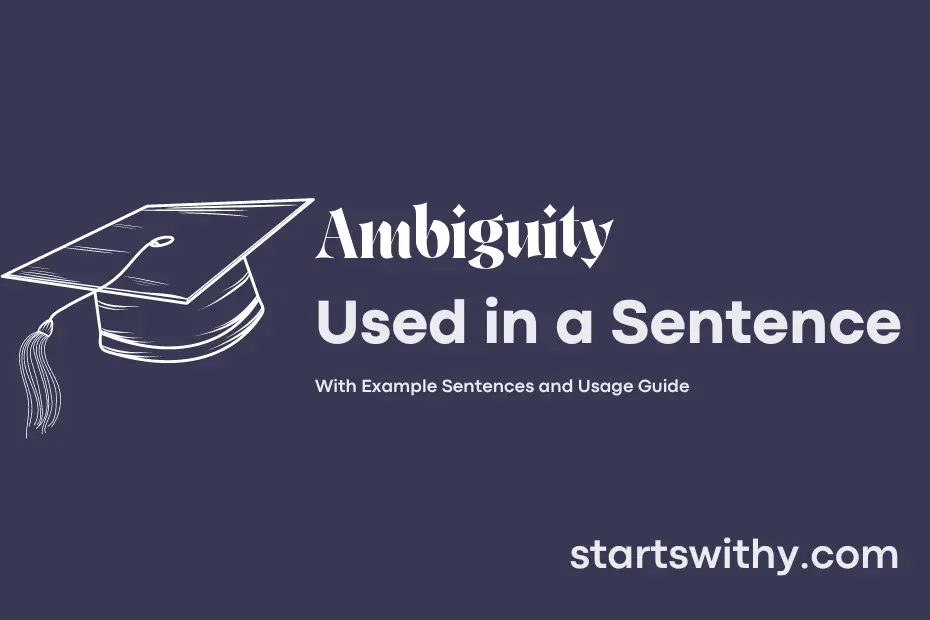Have you ever encountered a sentence that left you puzzled about its meaning or intention? This type of sentence often contains ambiguity, a literary device that allows for multiple interpretations and adds depth to the writing. Ambiguity can be intentional or unintentional, leading to a sense of mystery or confusion for the reader.
By incorporating ambiguity into a sentence, a writer can encourage critical thinking and engage the reader in deciphering the intended meaning. It adds a layer of complexity to the text, sparking curiosity and inviting different perspectives. Let’s explore how ambiguity can be effectively used to create intrigue and stimulate thought in writing.
7 Examples Of Ambiguity Used In a Sentence For Kids
- The ambiguity of the magic trick made everyone wonder how it worked.
- The riddle was full of ambiguity, making it hard to find the answer.
- The shadow looked like a big monster, but it was all just ambiguity.
- The map had an ambiguity that needed to be cleared up before we could find our way.
- The teacher’s smile was filled with ambiguity, making the students curious.
- The cloud shapes in the sky had a sense of ambiguity, making it fun to guess what they looked like.
- The story had an ending that left some ambiguity, allowing the readers to imagine their own version.
14 Sentences with Ambiguity Examples
- The professor’s instructions on the essay assignment were full of ambiguity, leaving the students confused about what was expected.
- During the debate competition, the judge’s feedback was vague and filled with ambiguity, making it challenging for the contestants to improve.
- The syllabus for the upcoming exam is filled with ambiguity, making it hard for students to know which topics to focus on.
- The new campus policy regarding attendance has caused ambiguity among students, as it is unclear how strict the consequences will be.
- The college’s guidelines on plagiarism are riddled with ambiguity, leading to uncertainty among students on what constitutes as an offense.
- The professor’s response to the student’s question was laced with ambiguity, making it difficult for the student to understand the concept fully.
- The group project instructions provided by the professor were vague and full of ambiguity, causing confusion among the students on how to proceed.
- The feedback given by the college counselor regarding career options was vague and filled with ambiguity, leaving students unsure about their future paths.
- The guidelines for the internship application process were unclear and filled with ambiguity, making it challenging for students to know how to proceed.
- The instructions for the research paper were ambiguous and lacking in detail, causing ambiguity among students on what the expectations were.
- The college’s policy on late submissions is full of ambiguity, making it unclear to students what the consequences will be for turning in assignments after the deadline.
- The grading rubric for the presentation was ambiguous and unclear, resulting in ambiguity among students on how their work would be evaluated.
- The university’s new rules on extracurricular activities are riddled with ambiguity, leaving students unsure about what is permitted or not.
- The guidelines for the scholarship application process are vague and full of ambiguity, making it hard for students to understand the criteria for eligibility.
How To Use Ambiguity in Sentences?
Ambiguity can be a powerful tool in writing, allowing for multiple interpretations of a sentence. To use ambiguity effectively as a beginner, consider the following tips:
-
Context: Provide enough context for the reader to understand the overall meaning of your sentence. This sets the stage for the ambiguity to add depth or nuance.
-
Placement: Place the ambiguous word or phrase strategically within the sentence. This can create tension or intrigue as the reader grapples with multiple possible meanings.
-
Punctuation: Experiment with punctuation, such as commas or dashes, to signal that the sentence contains ambiguity. This can guide the reader in navigating the multiple interpretations.
-
Word Choice: Select words with multiple meanings or nuances to introduce ambiguity. This can add layers to your writing and spark the reader’s imagination.
-
Clarity: While ambiguity can be a valuable literary device, ensure that your sentence remains coherent and meaningful. Avoid creating confusion that detracts from the overall message.
-
Feedback: Seek feedback from others to understand how different readers interpret your ambiguous sentence. This can help you refine your writing and improve your use of ambiguity.
By following these tips, you can effectively use ambiguity in a sentence to engage your readers and evoke a sense of intrigue and curiosity. Practice experimenting with different techniques and observe how ambiguity can enhance your writing style.
Conclusion
Ambiguity in sentences arises when the meaning is unclear or can be interpreted in more than one way. It can lead to confusion, misunderstandings, and miscommunication. To avoid ambiguity, it is crucial to be precise and clear in the way you structure sentences.
By carefully constructing sentences with clarity and eliminating any potential for multiple interpretations, communication can be enhanced, leading to better understanding between parties. Being mindful of ambiguity in sentences can help in conveying your message effectively and ensuring that your words are interpreted as intended.



